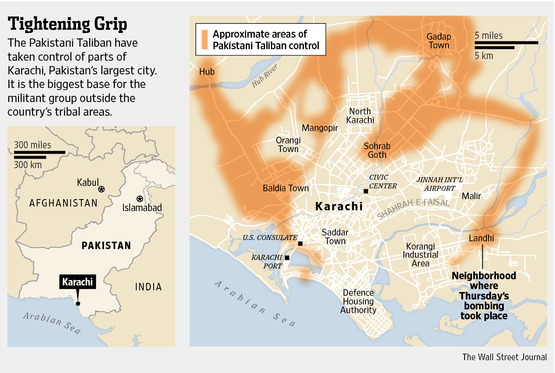
We lost East Pakistan in 1971. Our grip on FATA is tenuous and could slip away completely if government finally caves in to Taliban demands in peace talks. Former Chief Minister Akhtar Mengal has warned that Pakistan could lose Balochistan if the situation there is not resolved. Today, Karachi too can be added to the list of areas that are falling out of state control as the nation begins to unravel.
Known as the Gateway to Pakistan, Karachi is the nation’s largest city and the heart of the national economy. It is also known for having a messy political situation. Battles between political parties and alleged ties to mafias have been well documented. however, these issues may have held Karachi back from reaching its full potential, but they were never really a threat to the national security.
Today, though, Karachi is besieged by a new and more deadly threat. The Taliban have taken control of much of the city, and are now fighting not for political spoils, but to deal a death blow to Pakistan by striking directly in its heart.
Research by The Wall Street Journal shows that Taliban militants have been taking over control of the city:
Research by The Wall Street Journal, based on conversations with security officials and urban planners, shows TTP still control or dominate about 470 square miles of Karachi, or nearly a third of its area, where at least 2.5 million people live.
TTP’s sway in Karachi extends right up to Saddar—the city center—and into areas such as Sultanabad, a ramshackle community next to the new U.S. Consulate compound.
These are districts with a majority population of Pashtuns, the same ethnic group as TTP’s leadership. These areas that encircle the city include Baldia and the Sindh Industrial Trading Estate to the west and Gadap in the north. Residents in these areas said TTP’s hold had gotten stronger over the past year.
In addition to the main TTP faction from the Mehsud tribe of South Waziristan in the tribal areas, long established in Karachi, the city is increasingly plagued by another TTP faction from the Mohmand tribal area, police officers said, along with TTP Swat.
Islamist militants also have influence over some non-Pashtun districts of the city, such as Lyari in the southwest where TTP ally Lashkar-e-Jhangvi has a base. TTP has an ability to stage attacks across Karachi.
TTP dominates 33 of Karachi’s 178 administrative units—known as union councils— security officials said. These tend to be the larger, peripheral, districts, with ever expanding shanty settlements that eat into the surrounding desert. The militants are also now getting more educated recruits, including non-Pashtuns, and spreading to neighboring areas outside Karachi, including Hub to the west and Jamshoro to the northeast.
In the areas it controls, TTP is levying a tax on residents and businesses, said a businessman in Sohrab Goth, a Taliban-run neighborhood just north of the city center.
The militant group has set up courts in neighborhoods to resolve disputes, which give written judgments, handling matters that include disagreements over land ownership and regulating levels of theft from power lines that they allow, residents said.
Recent Taliban attacks in Karachi including the murder of SSP Chaudhry Aslam demonstrate just how desperate the situation has become. Even during so-called ‘peace talks’, Taliban have carried out not one but two bomb attacks against security forces in Karachi, and CID police have arrested al Qaeda militants with even more explosives.
There is a saying that ‘As goes Karachi, so goes the country.’ Today, it is a warning we should not ignore.
![]()






[…] ← Previous […]